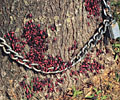General Information
 Boxelder
bugs are elliptical and about 0.5
inch long. The thorax has 3 red
stripes; the leathery parts of the
wings are outlined in red; and the
eyes are red. The remainder of the
insect is dark gray or black.
Initially eggs are light yellow, but
darken to rusty red. Each has a
distinct cap. Nymphs are
conspicuously bright red; older
nymphs have dark gray wing pads. The
head, legs and antennae are gray. Boxelder
bugs are elliptical and about 0.5
inch long. The thorax has 3 red
stripes; the leathery parts of the
wings are outlined in red; and the
eyes are red. The remainder of the
insect is dark gray or black.
Initially eggs are light yellow, but
darken to rusty red. Each has a
distinct cap. Nymphs are
conspicuously bright red; older
nymphs have dark gray wing pads. The
head, legs and antennae are gray.
Biology
The boxelder bug is found throughout
North Carolina. Besides boxelder
tree seeds, this insect has been
recorded as feeding on apple, ash,
buckeye, cactus, geranium, grape,
honeysuckle, lilac, linden, oak,
peach, plum, spirea, strawberry, and
tulip. Alder, maple and boxelder
trees are most often infested but
trees are seldom injured. Fruit
trees and strawberries have
occasionally had fruits damaged.
Although boxelder bugs are
associated with shade trees, this
insect is more commonly a household
pest. In fall, boxelder bugs tend to
congregate on buildings and enter
cracks and crevices to overwinter.
They do not bite people or harm
goods, but their presence is a
nuisance. On warm winter days, the
insects become active and move about
in and on buildings and cause
concern for the homeowner.
 Adult boxelder bugs emerge from their
overwintering shelters in March and
early April and feed for about 2 weeks
before mating. These insects prefer
sunny areas and, therefore, are found
most abundantly on trees in a southern
exposure and on sides of buildings
facing south. Eggs are deposited in
masses of 10 or 11 eggs usually in bark
crevices. Each female deposits about 230
eggs. The eggs hatch in about 2 weeks.
Development of the six nymphal stages
takes 50 to 70 days. The boxelder bug
population increases rapidly from middle
July to early September. Two generations
are produced each year. The insects seek
overwintering places in September and
October. Only the adults survive the
winter.
Adult boxelder bugs emerge from their
overwintering shelters in March and
early April and feed for about 2 weeks
before mating. These insects prefer
sunny areas and, therefore, are found
most abundantly on trees in a southern
exposure and on sides of buildings
facing south. Eggs are deposited in
masses of 10 or 11 eggs usually in bark
crevices. Each female deposits about 230
eggs. The eggs hatch in about 2 weeks.
Development of the six nymphal stages
takes 50 to 70 days. The boxelder bug
population increases rapidly from middle
July to early September. Two generations
are produced each year. The insects seek
overwintering places in September and
October. Only the adults survive the
winter.
Boxelder bugs have unusual feeding
preferences. Because these insects feed
primarily on boxelder and maple seeds,
the insects are found on the ground
beneath female trees in the early summer
before the seeds start to develop. The
bugs move into the trees once seeds
begin to form. These insects are
cannibalistic, particularly when the
victim is molting, and they have been
reported to feed on other dead or dying
insects.
|
